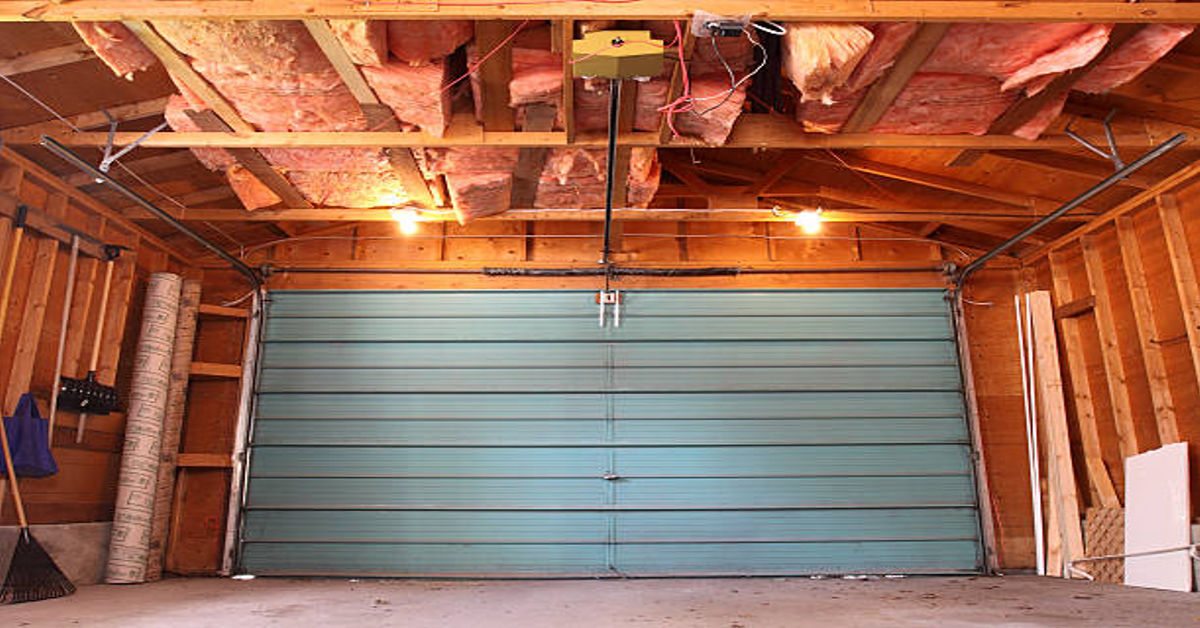When people think about home insulation, they often focus on walls, attics, and windows, but one major area that is frequently overlooked is the garage door. The garage is a large space directly connected to or adjacent to many homes, and its temperature and insulation can significantly influence overall energy efficiency. Whether you use your garage as a workspace, a storage area, or simply a place to park your car, insulating the garage door can make a substantial difference in comfort, energy savings, and the longevity of your door system.
This comprehensive guide explores everything you need to know about garage door insulation — including how it works, the types of materials available, the installation process, the costs involved, and the many benefits it provides. By understanding these factors in detail, homeowners can make informed decisions that improve both the functionality and efficiency of their homes.
1. Understanding Garage Door Insulation
Garage door insulation refers to the process of adding a thermal barrier to the inside panels or layers of your garage door. The purpose is to reduce the rate of heat transfer between the interior of the garage and the outdoors. In simple terms, insulation acts as a shield — keeping hot air out in summer and cold air out in winter.
Insulated garage doors differ from standard uninsulated doors in both structure and performance. While an uninsulated door is typically a single layer of steel or aluminum, an insulated door consists of multiple layers, often including an insulating core made from materials such as polyurethane or polystyrene. The result is a door that is more energy-efficient, quieter, and stronger.
Because garages can have significant temperature fluctuations, insulation helps stabilize these extremes. This stability not only benefits the contents stored inside the garage but also contributes to overall home comfort, particularly if the garage shares walls or ceilings with living spaces.
2. Why Garage Door Insulation Matters
Insulating your garage door can offer numerous advantages that go far beyond comfort. It can improve your home’s energy efficiency, reduce noise, and increase the door’s durability. Below are some of the key reasons insulation matters:
A. Energy Efficiency
An insulated garage door reduces heat loss during winter and heat gain during summer. This is especially beneficial if your garage is attached to your house or if there are rooms above or adjacent to it. Energy savings from insulation translate directly into lower heating and cooling costs.
B. Temperature Regulation
For garages used as workshops, studios, or gyms, stable temperatures are crucial. Insulation helps maintain a moderate environment that makes the space more usable throughout the year, regardless of outside conditions.
C. Noise Reduction
Insulated garage doors are significantly quieter than uninsulated ones. The extra layers of material help absorb vibrations and sound waves, minimizing noise from both operation and external sources such as traffic or wind.
D. Structural Strength
The added layers in insulated doors increase their strength and rigidity. This makes the door less prone to dents, warping, or damage from daily use, extending its lifespan.
E. Improved Comfort and Functionality
If you spend time in your garage working on hobbies, crafts, or repairs, insulation enhances comfort by keeping temperatures consistent. It can also protect sensitive equipment, tools, and stored items from temperature extremes and humidity.
F. Environmental Impact
By reducing energy consumption, garage door insulation indirectly contributes to lower carbon emissions and a smaller ecological footprint. It’s a simple but effective way to make your home more environmentally responsible.
3. How Insulation Works: The Science Behind It
To understand how garage door insulation improves comfort and efficiency, it’s essential to grasp the basic principles of heat transfer. There are three main types of heat transfer: conduction, convection, and radiation.
- Conduction occurs when heat moves through a solid material, such as a metal garage door.
- Convection refers to heat transfer through air movement. In garages, air leaks around doors contribute to this effect.
- Radiation involves heat traveling in the form of infrared waves from warm surfaces to cooler ones.
Insulation works by slowing down conduction and reducing the effects of convection and radiation. Materials like polyurethane and polystyrene contain air pockets or foam structures that resist heat flow, keeping indoor and outdoor temperatures from quickly equalizing.
R-Value and U-Factor
The performance of insulation is often measured by its R-value — a rating that indicates resistance to heat flow. The higher the R-value, the better the insulating performance.
The U-factor, on the other hand, measures how much heat passes through a material. Lower U-factors indicate higher energy efficiency.
| Material Type | Approx. R-Value (per inch) | Common Use |
|---|---|---|
| Polystyrene | 3.5 – 4.5 | Moderate insulation, cost-effective |
| Polyurethane | 6 – 7.5 | High insulation, premium option |
| Fiberglass | 3 – 4 | Budget-friendly, flexible installation |
| Reflective Foil | 1 – 2 | Supplemental radiant barrier |
The effectiveness of insulation depends not just on material but also on door design, local climate, and installation quality.
4. Types of Garage Door Insulation
Different materials are used for garage door insulation, each offering distinct advantages, performance levels, and costs.
A. Polystyrene Insulation
Polystyrene, commonly found in rigid foam board form, is one of the most widely used materials for garage door insulation. It is lightweight, affordable, and easy to cut and fit into door panels. While it offers decent thermal resistance, it doesn’t seal all gaps completely, so it may not be as energy-efficient as polyurethane.
Advantages:
- Cost-effective and easy to install
- Moisture-resistant and durable
- Provides moderate insulation
Limitations:
- Lower R-value compared to polyurethane
- Can leave small gaps that allow heat transfer
B. Polyurethane Insulation
Polyurethane is a dense foam injected between door layers. It expands to fill gaps, creating a solid, highly efficient insulation layer. This material provides superior temperature control, soundproofing, and structural strength.
Advantages:
- High R-value (best thermal performance)
- Strengthens door panels and reduces noise
- Energy-efficient and long-lasting
Limitations:
- More expensive than other materials
- Professional installation often required
C. Fiberglass Insulation
Fiberglass batts can be fitted into the interior of the garage door. It’s flexible and effective for irregular surfaces but must be sealed properly to prevent fibers from becoming airborne.
Advantages:
- Affordable and widely available
- Provides good sound absorption
Limitations:
- Can absorb moisture if not sealed
- Requires careful handling during installation
D. Reflective Foil Insulation
Reflective foil or radiant barrier insulation works by reflecting heat away rather than absorbing it. It’s best suited for hot climates where the goal is to block radiant heat from the sun.
Advantages:
- Lightweight and easy to install
- Ideal for reflecting solar heat
Limitations:
- Limited insulation in cold weather
- Usually used as a supplemental layer
5. Choosing the Right Insulation for Your Garage Door
Selecting the right insulation depends on various factors, including climate, budget, and intended garage use.
| Consideration | Recommended Material | Notes |
|---|---|---|
| Cold Climate | Polyurethane | High R-value retains warmth efficiently |
| Hot Climate | Reflective Foil | Deflects solar radiation effectively |
| Budget Project | Polystyrene or Fiberglass | Balance between cost and performance |
| Noise Reduction | Polyurethane or Fiberglass | Provides acoustic dampening |
| DIY Installation | Polystyrene Panels | Simple to cut and install |
Homeowners should also consider whether the garage is attached to the main house, how often it’s used, and whether it’s climate-controlled.
6. Installation Methods
Garage door insulation can be installed professionally or as a DIY project. The process and difficulty level depend on the material type and the door design.
DIY Installation Steps
- Measure Panels: Determine the dimensions of each door panel to cut insulation precisely.
- Select Material: Choose foam board, fiberglass batts, or reflective foil according to climate and needs.
- Cut Insulation: Use a utility knife for foam or foil; scissors for fiberglass.
- Attach Insulation: Use double-sided adhesive tape, clips, or retainer pins to secure panels.
- Seal Edges: Apply weather stripping or aluminum tape to seal air gaps.
- Test Operation: Open and close the door to ensure smooth functionality.
Professional Installation
Professional services may cost more but ensure correct fitting, proper sealing, and long-term durability. They often include custom-fitted insulation and weather stripping, ensuring optimal performance and appearance.
7. Cost of Garage Door Insulation
Costs vary based on material, labor, and door size. Below is an approximate cost comparison:
| Type of Insulation | DIY Cost (per door) | Professional Installation | Average R-Value |
|---|---|---|---|
| Polystyrene | $50 – $150 | $200 – $400 | 4 – 6 |
| Polyurethane | $100 – $250 | $400 – $800 | 6 – 8 |
| Fiberglass | $70 – $200 | $250 – $500 | 3 – 5 |
| Reflective Foil | $40 – $120 | $150 – $300 | 1 – 3 |
Though initial costs vary, insulated doors often pay for themselves over time through reduced energy bills and lower maintenance costs.
8. Maintenance and Longevity
Properly insulated garage doors require minimal additional maintenance. However, to ensure lasting performance:
- Inspect weather stripping and seals twice a year.
- Keep panels clean to prevent corrosion or warping.
- Lubricate hinges and springs regularly to prevent strain from added weight.
- Reapply sealants or adhesives as needed to prevent gaps.
Well-maintained insulated doors can last 15–20 years or longer, depending on material and environmental conditions.
9. Energy Savings and Efficiency Gains
The potential energy savings from garage door insulation depend on your home’s structure and climate. In attached garages, insulation can reduce heat loss by 15–20%, lowering overall heating and cooling costs.
For homes where the garage shares a wall with interior rooms, insulation prevents temperature transfer, reducing the load on HVAC systems. Even detached garages benefit by maintaining more consistent temperatures that protect stored vehicles, tools, and machinery.
| Climate Type | Potential Energy Savings | Comfort Level Increase |
|---|---|---|
| Cold (Snowy) | 15–25% | High |
| Mild (Temperate) | 10–15% | Moderate |
| Hot (Desert) | 20–30% | High |
These improvements not only make the garage more comfortable but also increase the resale value of the home.
10. Environmental and Comfort Benefits
Beyond financial and comfort advantages, insulated garage doors have positive environmental effects. Reduced energy consumption decreases greenhouse gas emissions, contributing to sustainability. Insulated materials like polyurethane also provide soundproofing, minimizing external noise.
For families, comfort extends to safety — consistent temperatures prevent mold, protect electronics or paints from freezing, and preserve stored food or beverages in attached garages.
11. Comparing Insulated vs. Non-Insulated Garage Doors
| Feature | Insulated Door | Non-Insulated Door |
|---|---|---|
| Energy Efficiency | High | Low |
| Temperature Control | Stable | Fluctuates |
| Noise Reduction | Excellent | Minimal |
| Strength | Rigid and durable | Prone to dents |
| Cost | Higher initial, long-term savings | Lower initial, higher energy cost |
| Comfort | Year-round usability | Limited use in extreme climates |
While non-insulated doors are adequate for detached garages in mild climates, insulated doors are strongly recommended for attached or frequently used garages.
12. Common Mistakes to Avoid
- Ignoring Air Leaks: Even with insulation, unsealed gaps around the door edges reduce effectiveness.
- Using the Wrong Material: Each climate demands a specific insulation type; mismatched choices lead to poor performance.
- Improper Installation: Loose panels or incomplete sealing cause rattling, gaps, and heat loss.
- Neglecting Weight Balance: Adding insulation increases door weight, which may require spring adjustment.
Avoiding these mistakes ensures lasting comfort, efficiency, and smooth door operation.
13. When to Replace Instead of Insulate
Sometimes, replacing the entire garage door with a pre-insulated model is more practical than retrofitting insulation. Replacement is ideal if:
- The existing door is rusted or warped.
- Panels are damaged beyond repair.
- You want modern aesthetics and energy-efficient materials.
New insulated doors often feature steel or composite exteriors with polyurethane cores, providing both style and performance.
14. Future Trends in Garage Door Insulation
Technology continues to enhance insulation efficiency. Innovations include eco-friendly foam materials, recycled composites, and smart temperature-control systems. Manufacturers are developing high-density foams with superior R-values and sustainable ingredients to reduce environmental impact.
Smart garages equipped with thermal sensors and Wi-Fi-connected openers now monitor temperature and energy consumption, allowing users to optimize conditions in real time.
15. Conclusion: The Lasting Value of Garage Door Insulation
Garage door insulation is a small home improvement with significant rewards. It enhances comfort, reduces energy bills, minimizes noise, and increases the structural integrity of your garage door. Whether you live in a cold northern climate or a hot desert region, insulation provides benefits all year long.
Investing in the right insulation material and proper installation can transform your garage from a drafty, uncomfortable space into a functional, energy-efficient extension of your home. Beyond its immediate advantages, it adds property value and aligns with sustainable living practices — making it one of the most worthwhile upgrades for any homeowner.
Ultimately, a well-insulated garage door not only protects your belongings but also contributes to a more efficient and environmentally conscious lifestyle.
Frequently Asked Questions (FAQs)
1. What is the best material for garage door insulation?
Polyurethane is the best overall material for garage door insulation due to its high R-value, strength, and energy efficiency.
2. Can I insulate my existing garage door myself?
Yes. DIY insulation kits using polystyrene or reflective foil are available. However, professional installation ensures better sealing and durability.
3. How much energy can garage door insulation save?
Insulated garage doors can reduce energy loss by up to 20–30%, especially in attached garages sharing walls with living areas.
4. Does insulation make garage doors heavier?
Yes, insulation adds slight weight, but this can be balanced by adjusting the torsion springs to maintain proper door operation.
5. How long does insulated garage door material last?
With proper maintenance, insulated garage doors can last 15–25 years, depending on material quality and environmental conditions.











